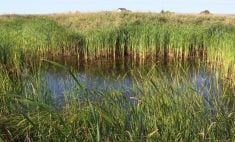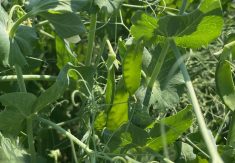
In July 2020, I was doing some routine scouting for Greg, who farms seed canola, wheat, lentils, seed alfalfa, flax, dry beans and corn in the Grassy Lake area.
I noticed a lentil field under irrigation had a portion of the crop located on a slight hilltop quickly yellow off, mature and slowly die off, while other parts of the field remained green and healthy, with many pods having two seeds.
This was odd. The previous week the field was green and healthy, with a slight tinge of yellow, but nothing overly alarming. I had noticed it had slightly less biomass than other areas of the field but there was no visible mould.
Now things were different. There was extreme yellowing in this portion of the field that followed the hilltop and a major decrease in biomass. We experienced extremely hot temperatures in between the two field visits.
Read Also

Claas brings 1000 Series SP forage harvesters to Canada
In mid-August, Claas unveiled its new line of Jaguar forage harvesters at an event in Visalia, California, deep in the heart of that state’s dairy region.
Our first instinct was to consider an insect or disease issue. The yellowing followed a distinct pattern and was isolated to that part of the field. Mould was just starting to set in at the bottom of the canopy, but not in the other healthy parts of the field.
Could it be aphids? The population was below the economic threshold, and it didn’t make sense that they were affecting this part of the field only. Aphids also typically affect the pods only and not the entire plant.
Roots were healthy and nodules were pink and healthy upon inspection. Seed treatment and an inoculant had been used, and Greg implemented a long rotation between host crops. Lentils had never been grown on this part of his farm before.
Could it be an issue with a previous herbicide application? The pattern did not follow the sprayer tracks in the field. Fertilizer deficiency could be ruled out, as we had put down adequate and safe rates with the seed. A fungicide had been applied two weeks earlier and was used according to the label.
Something else was at work here, but what?
Crop advisor solution: Drought stress causes lentil damage
Something didn’t add up. We went back and dug up some more roots, just to be sure we hadn’t missed something. I noticed the soil in the affected area felt different than the rest of the field. The soil texture in that area was extremely sandy — this detail and the pattern were confirmed with digital imagery.
Recently, we had experienced a large downpour, which would’ve mostly run off to the low spots, leaving the hilltops extremely dry.
We had also experienced very warm temperatures, and these plants were experiencing drought symptoms. This drought stress led to the occurrence of mould in those parts of the field, despite a preventive fungicide being used.
Unfortunately, there were no real management changes to make for this season. We could have watered more, but due to a low spot and concerns about the viability of the rest of the field, the decision was made to leave everything be, as to not drown out the bottom portion of the field and to not prolong harvest of the healthy portion of the crop.

In 2021, Greg planted winter wheat. Last fall and this spring we noticed the plants on the sandbar were showing a nitrogen deficiency at about the three- to four-leaf stage and the soil profile was about 10 to 15 per cent drier than other parts of the field.
For 2022, we will have our irrigation stake in more spots of the field to better access more acres under the pivot. It is a difficult field to manage because water sits at the north end compared with the south end, which has a sandbar running thought it.
Greg’s yield was lower on the hilltop, which was to be expected, but lentil quality was still good. We are working together to irrigate that field differently for the next season.
Ashley Gill, RTAg, CCA, works for Richardson Pioneer Ltd. in Bow Island, Alta.
Editor’s Note: Saying goodbye to Crop Advisor Casebook
Crop Advisor Casebook is a well-loved and popular feature of Grainews. Farmers, agrologists, researchers, ag extension personnel and more tuned in to each issue to solve the agronomic mystery posed by Richardson Pioneer crop advisors.
After much deliberation, Richardson Pioneer has decided to end the Crop Advisor Casebook feature in Grainews.
I have been faithfully reading Crop Advisor Casebook for more than a decade. One of my favourite cases appeared in 2017, when a farmer named Jim found crop circles in his canola field. Jim jokes to Josefine Bartlett, who was helping him diagnose the issue, “Maybe it’s aliens.”
It turns out fungi was responsible for Jim’s crop circle conundrum and not invaders from space. The fungi grow in the soil and absorb nutrients, and as it moves outward as soil nutrients are depleted, the fungi create circular shapes called fairy rings. Like many of the casebooks, this one was educational and entertaining. There were also casebook files that challenged everyone, attracting attention from farmers, other agrologists and academics.
It was the Richardson crop advisors who, year in and year out despite how busy the season was, provided us with their case notes. And we all learned from their deep pool of agronomic insights and understanding.
Crop Advisor Casebook will be greatly missed by all. I would like to sincerely thank all of the crop advisors who gave their time to support the casebook. Your efforts are greatly appreciated by Grainews and our readership.
– Kari Belanger















